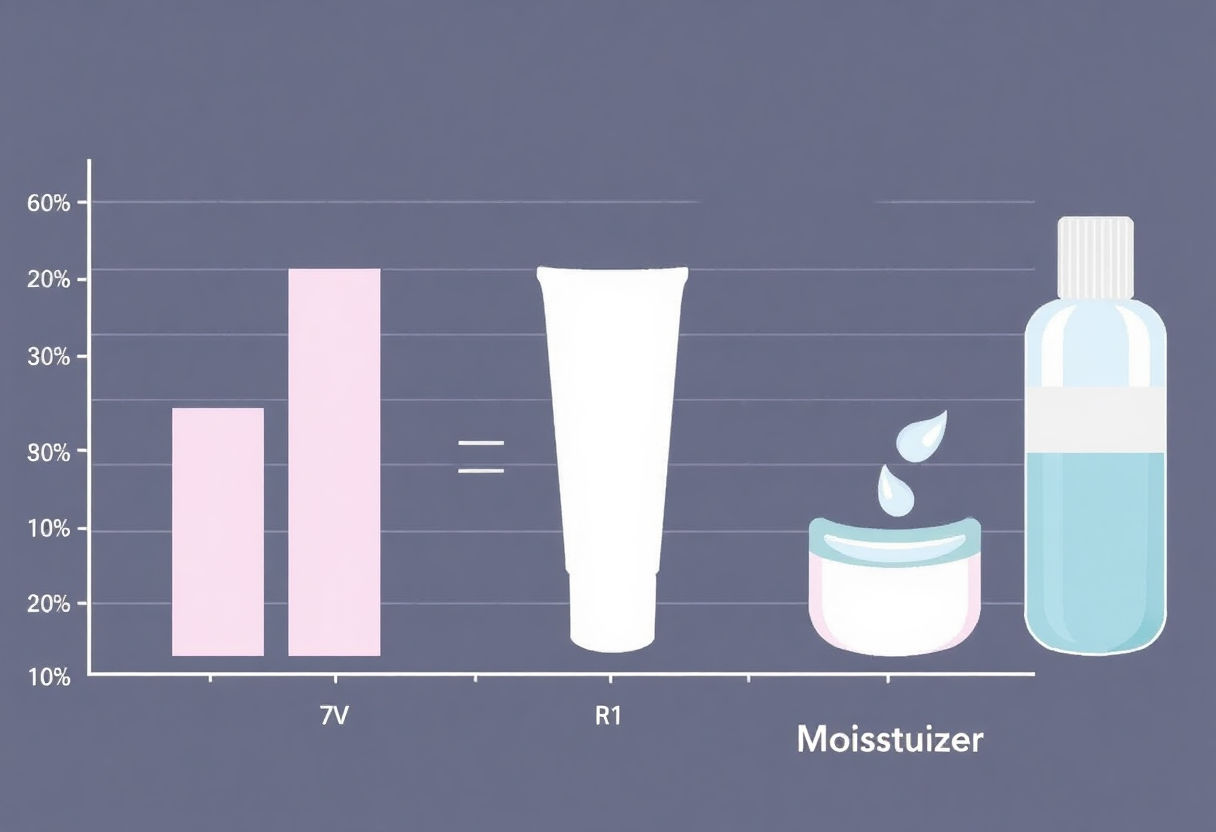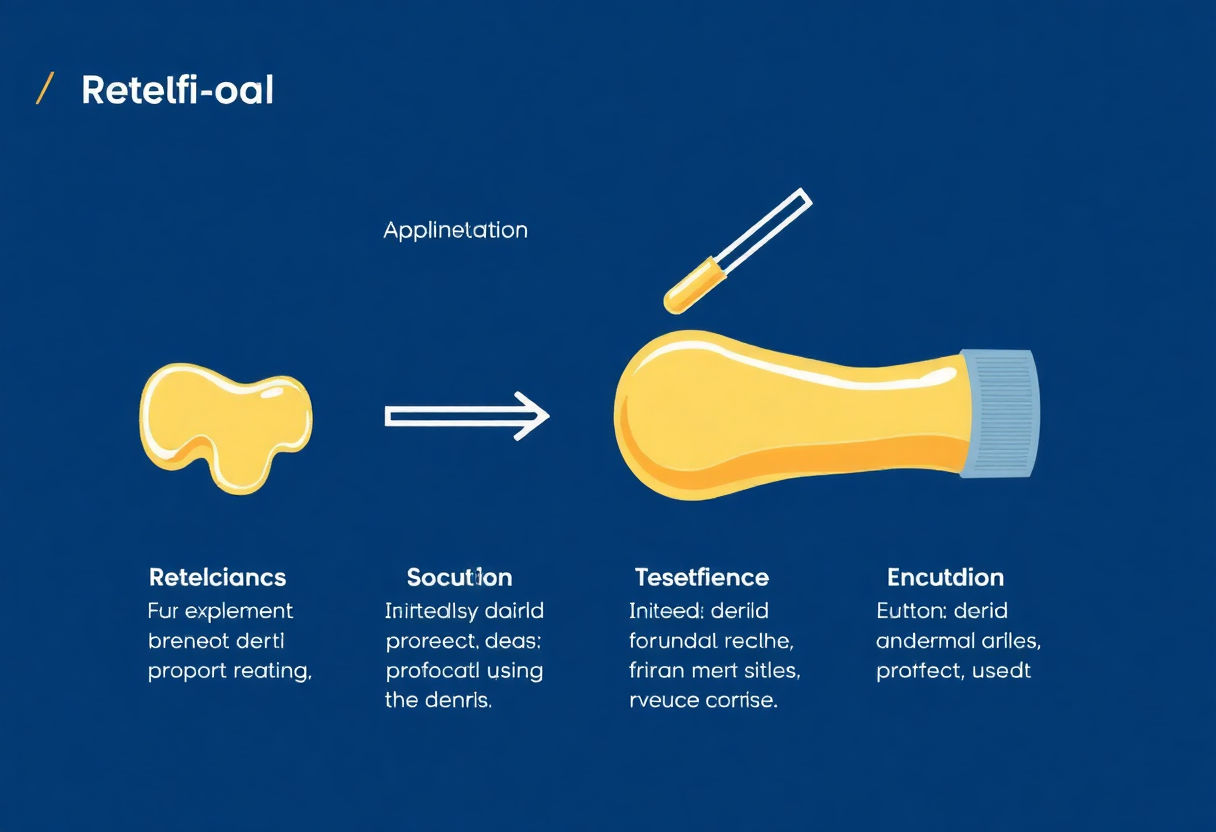In today’s labyrinth of skincare products, retinol and moisturizer stand out as fundamental pillars for achieving radiant and youthful skin. While retinol is renowned for its anti-aging benefits, it often presents challenges like irritation and dryness, necessitating a strategic approach to application. Moisturizers, on the other hand, are crucial for maintaining skin hydration and enhancing its barrier function. This article delves into understanding these products, their synergistic use, and provides insights into selecting appropriate formulations. By following safe incorporation techniques, readers can maximize skin health and beauty, avoiding common pitfalls.
Key Takeaways
- Effectively integrating retinol and moisturizer into your skincare routine can significantly enhance skin health and appearance.
- Retinol is powerful for stimulating skin renewal but must be paired with a moisturizer to prevent dryness and irritation.
- Moisturizers are essential for maintaining the skin’s hydration and protecting the skin barrier when using retinol.
- Selecting the right products tailored to your skin type will optimize the benefits of both retinol and moisturizer.
- Following the recommended techniques reduces common pitfalls and maximizes the outcome of your skincare routine.
Understanding Retinol
Retinol, a derivative of vitamin A, is celebrated for its remarkable ability to enhance skin appearance. As the skincare industry continuously evolves, this potent ingredient has become a cornerstone in numerous dermatologic treatments. Retinol works by accelerating cell turnover, which aids in reducing the appearance of fine lines and wrinkles, promoting a smoother skin texture, and evening out skin tone.
One of the most noteworthy benefits of retinol is its capacity to boost collagen production. Collagen, a vital protein responsible for skin firmness and elasticity, naturally diminishes with age. By encouraging collagen synthesis, retinol helps to maintain a youthful, resilient complexion.
Moreover, retinol is effective in treating acne. It unclogs pores and prevents the formation of new blemishes, making it a key component in many acne-fighting formulations. Individuals struggling with post-acne marks also find retinol beneficial, as its exfoliating properties facilitate improved skin tone and diminish hyperpigmentation.
However, despite its widespread popularity, retinol requires careful integration into skincare routines due to potential side effects such as redness, peeling, or increased sensitivity. Beginners are often advised to start with a low concentration and gradually increase usage to allow the skin to acclimate.
It is critical to note that retinol can make the skin more sensitive to UV rays. Thus, rigorous sun protection is essential to avoid exacerbating the very concerns retinol aims to resolve. Understanding its application and ensuring appropriate complementary products, such as moisturizers, can significantly enhance its effectiveness, ultimately paving the way for optimal skincare results.
The Role of Moisturizers
 Moisturizers play a vital role in any skincare routine, particularly when using potent active ingredients like retinol. They are essential in maintaining skin hydration, which is fundamental for keeping the skin supple, smooth, and resilient. Retinol, while highly effective in addressing signs of aging and promoting cell turnover, can often lead to dryness and increased sensitivity. This is where moisturizers become indispensable. By sealing in moisture, they help mitigate these side effects, ensuring the skin barrier remains intact and well-protected.
Moisturizers play a vital role in any skincare routine, particularly when using potent active ingredients like retinol. They are essential in maintaining skin hydration, which is fundamental for keeping the skin supple, smooth, and resilient. Retinol, while highly effective in addressing signs of aging and promoting cell turnover, can often lead to dryness and increased sensitivity. This is where moisturizers become indispensable. By sealing in moisture, they help mitigate these side effects, ensuring the skin barrier remains intact and well-protected.
Moisturizers work by creating a barrier over the skin, preventing water loss and enhancing the skin’s natural hydration levels. This barrier also serves as a protective shield against environmental stressors like pollution and harsh weather conditions, which can exacerbate dryness and irritation. A well-chosen moisturizer can aid in calming and soothing the skin, reducing any redness or inflammation that might be caused by retinol use.
For optimal results, selecting the right moisturizer is crucial. It should contain ingredients that complement retinol’s action while replenishing moisture. Look for products enriched with humectants like hyaluronic acid or glycerin to draw moisture into the skin, and emollients such as ceramides or fatty acids to lock in hydration.
Integrating moisturizers into your retinol regimen not only enhances the performance of both products but also ensures your skin remains balanced and healthy. This approach not only amplifies the benefits of retinol but also minimizes potential adverse effects, making it a cornerstone of effective skincare.
How Retinol and Moisturizer Work Together
 Retinol and moisturizer, when combined judiciously, can lead to a transformative skincare regimen. While retinol is renowned for its potent ability to accelerate cell turnover and stimulate collagen production, it may sometimes lead to dryness and irritation. This is where the critical role of a moisturizer comes into play, providing essential hydration and barrier support to mitigate potential side effects.
Retinol and moisturizer, when combined judiciously, can lead to a transformative skincare regimen. While retinol is renowned for its potent ability to accelerate cell turnover and stimulate collagen production, it may sometimes lead to dryness and irritation. This is where the critical role of a moisturizer comes into play, providing essential hydration and barrier support to mitigate potential side effects.
Using a moisturizer alongside retinol not only helps in alleviating dryness, but also enhances the overall effectiveness of your skincare routine. When applied in tandem, moisturizer can act as a buffer, allowing the skin to gradually acclimate to retinol’s powerful effects. This synergy can result in smoother, more resilient skin as it combats signs of aging and improvements in texture and tone without significant discomfort.
Here are a few key strategies for maximizing the benefits:
- Layer smartly: For optimal results, apply retinol on freshly cleansed skin and, once absorbed, follow with a gentle, hydrating moisturizer. This sequence ensures that retinol maintains close contact with the skin to effectively perform its functions while the moisturizer seals in hydration.
- Opt for gentle formulations: Choose moisturizers that are free from irritating ingredients such as alcohol or heavy fragrances. Look for products containing soothing agents like hyaluronic acid and ceramides to further enhance hydration.
- Monitor skin response: As with any skincare regimen, pay close attention to how your skin reacts. Adjust the frequency of retinol application or switch moisturizers if any signs of irritation persist.
These strategies illuminate the complementary relationship between retinol and moisturizers, transforming this powerful duo into a cornerstone of effective skincare.
Choosing the Right Products
 Choosing the right retinol and moisturizer products for your skin type is a critical step in maximizing the benefits of your skincare regimen. Not all products are created equal, and selecting the appropriate formula can make a significant difference in achieving optimal results.
Choosing the right retinol and moisturizer products for your skin type is a critical step in maximizing the benefits of your skincare regimen. Not all products are created equal, and selecting the appropriate formula can make a significant difference in achieving optimal results.
When it comes to retinol, consider the following factors:
- Concentration: Beginners should start with a lower concentration, such as 0.25% to 0.5%, to allow the skin to acclimate. For those with more experience, higher concentrations can be considered to enhance results.
- Formulation: Retinol is available in various formulations, including creams, gels, and serums. Choose a formulation that complements your skin type: oily skin may benefit from a gel, while dry skin might find a cream more nourishing.
- Packaging: Retinol is sensitive to light and air, so products in opaque, air-tight packaging can help maintain potency.
Selecting the best moisturizer involves:
- Skin Type Compatibility: For oily or acne-prone skin, opt for non-comedogenic, oil-free formulas. Conversely, dry skin benefits from richer, hydrating creams containing ingredients like hyaluronic acid or ceramides.
- Ingredients: Look for products containing antioxidants like vitamin E and peptides, which complement the effects of retinol by soothing the skin and reducing inflammation.
- Texture Preference: Choose a texture that feels comfortable throughout the day. Lightweight lotions may be ideal for daytime use, while thicker creams can offer intense hydration overnight.
Choosing high-quality products tailored to your individual needs ensures that you reap the full benefits of combining retinol and moisturizer in your skincare routine.
Incorporating Retinol Safely
 Incorporating retinol into your skincare routine requires careful consideration to ensure safety and efficacy. Here are essential steps for integrating retinol without causing irritation:
Incorporating retinol into your skincare routine requires careful consideration to ensure safety and efficacy. Here are essential steps for integrating retinol without causing irritation:
-
Start Slowly: Begin by applying retinol just once or twice a week. This gradual introduction allows your skin to build tolerance, minimizing the risk of irritation or peeling.
-
Use a Pea-Sized Amount: A small amount of retinol is sufficient for the entire face. Over-application can increase the likelihood of adverse reactions.
-
Apply on Dry Skin: After cleansing, wait until your face is completely dry before applying retinol. Moist skin can enhance retinol absorption, potentially leading to irritation.
-
Consider Time of Day: Retinol products are best applied at night. This is because retinol can increase photosensitivity, and nighttime use avoids sun exposure.
-
Pair with a Moisturizer: To combat potential dryness or irritation, follow up with a moisturizer. This helps maintain hydration and supports the skin’s barrier function.
Over time, as your skin adapts, you can increase the frequency of retinol application. However, always monitor your skin’s response and adjust usage accordingly. For individuals with sensitive skin, it might be beneficial to layer a moisturizer before and after applying retinol, often referred to as the “moisturizer sandwich” technique. This approach provides an extra buffer against irritation.
If redness, peeling, or discomfort persists, it’s recommended to reduce application frequency or consult a dermatologist. By taking these precautions, retinol can become a valuable asset in achieving radiant, youthful skin while minimizing potential side effects.
Moisturizing Techniques for Optimal Results
Moisturizing effectively is crucial when incorporating retinol into your skincare routine, as it helps maintain a healthy skin barrier and minimizes potential irritation. For optimal results, consider the following techniques:
-
Timing is Key: Apply moisturizer right after cleansing and using retinol. The skin is more permeable after cleansing, allowing moisturizers to work more effectively.
-
Layering Properly: Choose a lightweight hydrating serum to apply underneath a richer moisturizer. This combination helps to lock in moisture without overloading the skin.
-
Lock in Hydration: Use a moisturizer that contains ingredients like hyaluronic acid, glycerin, or ceramides. These components are excellent for binding moisture to the skin and reinforcing its natural barrier.
-
Amount and Application: Use a nickel-sized amount, and apply using gentle, upward strokes. Patting the product into the skin can also increase absorption and minimize irritation from manual manipulation.
-
Focus Areas: Pay extra attention to areas prone to dryness, such as around the eyes and mouth. These regions may require an additional layer for added protection.
-
Consistency and Frequency: Moisturize both morning and night consistently. Maintaining a regular practice ensures continuous hydration, which is especially important when using active ingredients like retinol.
A quote to remember: “Moisturizing is the key to unlocking the full benefits of your retinol product, providing both protection and nourishment to the skin.” By following these expert techniques, you can enhance the efficacy of your skincare regimen and achieve a balanced, radiant complexion.
Common Mistakes to Avoid
When integrating retinol and moisturizer into your skincare routine, awareness of common mistakes is crucial in avoiding potential adverse effects and achieving the desired results.
One prevalent error is applying retinol on damp skin. While moisturizing damp skin can help lock in hydration, retinol is best applied to dry skin to minimize irritation. Begin with a clean, dry face before applying retinol to ensure the product can be absorbed effectively without causing sensitivity.
Another frequent mistake is overusing retinol in the initial stages of your skincare regimen. Retinol is a powerful ingredient, and overuse can lead to redness, peeling, or increased sensitivity. Introduce retinol gradually, perhaps starting with every third night, to allow your skin to adapt. Incrementally increase usage once your skin builds tolerance.
Failing to apply sunscreen daily is a detrimental oversight. Retinol increases the skin’s sensitivity to sunlight, elevating the risk of sun damage. Regardless of weather conditions, a broad-spectrum sunscreen with at least SPF 30 should be applied every morning to protect and preserve the skin’s health and integrity.
Lastly, some individuals err by choosing incompatible moisturizers that do not complement retinol use. Opt for a gentle, hydrating moisturizer free from fragrances and harsh ingredients, which can exacerbate irritation. Look for products containing soothing agents like ceramides or hyaluronic acid to bolster the skin’s moisture barrier.
By avoiding these mistakes and understanding the nuanced interaction between retinol and moisturizers, you can foster a skincare routine that enhances your skin’s health and radiance.
Signs of Success: When Skincare is Working
 A successful skincare routine involving retinol and moisturizer reveals its efficacy through several noticeable signs. One primary indicator is improved skin texture, which often becomes smoother and softer. Over time, fine lines and wrinkles may appear less pronounced as retinol stimulates collagen production. This collagen boost enhances skin elasticity, contributing to a more youthful appearance.
A successful skincare routine involving retinol and moisturizer reveals its efficacy through several noticeable signs. One primary indicator is improved skin texture, which often becomes smoother and softer. Over time, fine lines and wrinkles may appear less pronounced as retinol stimulates collagen production. This collagen boost enhances skin elasticity, contributing to a more youthful appearance.
A healthy glow is another sign that your skincare regimen is working. Moisturizers, when used correctly, help maintain hydration levels, preventing dryness and flakiness. As moisture is locked in, the skin appears more radiant and supple.
Reduction in the visibility of pores is a further testament to the benefits of using retinol. By promoting cell turnover, retinol helps to clear clogged pores, minimizing their appearance and reducing breakouts.
Additionally, an even skin tone signifies the routine’s success. Hyperpigmentation and age spots may diminish with consistent retinol use, leading to a more uniform complexion. This effect is particularly beneficial for addressing sun damage and acne scars.
While these positive changes are apparent, patience is crucial. As dermatologist Dr. Smith notes, “Visible improvements typically take several weeks to manifest, reflecting the gradual yet effective transformation process.”
Key indicators of success include:
- Smoother and softer skin texture
- Reduction in fine lines and wrinkles
- More radiant and hydrated skin
- Diminished appearance of pores
- Evened-out skin tone
By recognizing these signs, you can confidently continue your skincare routine, knowing that your efforts are yielding positive results.
Conclusion
Incorporating retinol and moisturizer effectively into your skincare routine is crucial for achieving optimal skin health. By understanding their roles, selecting the right products, and applying them correctly, you can enjoy their synergistic benefits. Future advancements may offer even more tailored solutions for individual skin needs. Remember, patience is essential as visible changes take time. Embrace these techniques confidently, knowing they are foundational steps towards achieving your best skin.
Frequently Asked Questions
Can I use retinol and moisturizer together?
Yes, using retinol with a moisturizer is recommended to help minimize potential irritation and dryness, enhancing the skin’s tolerance to retinol.
How often should I apply retinol in my skincare routine?
Begin by using retinol every other night to allow your skin to adjust, then gradually increase to nightly use as your skin builds tolerance.
What type of moisturizer should I use with retinol?
Choose a moisturizer with ingredients that support skin barrier function, such as ceramides and hyaluronic acid, to enhance hydration and protection after retinol application.
Is there a specific time to apply retinol and moisturizer?
Apply retinol at night due to its photosensitivity, followed by a moisturizer to lock in hydration and protect the skin barrier during overnight recovery.
How long does it take to see results from using retinol and moisturizer together?
Results vary, but noticeable improvements in skin texture and appearance generally occur after several weeks of consistent use, with optimal results appearing after a few months.
